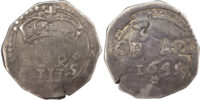Description
Charles I (1625-49), Three Shillings, 1645, Civil War obsidional coinage, Carlisle besieged, C.R crowned with pierced rosette either side, value .III.s below, contained within inner linear circle, cross on top of crown breaks circle, border of dots surrounding, six pellet jewels on crown band and on upper arches. Rev, legend in two lines, OBS CARL pellet in O, date below, pellets flanking either side, pierced rosette below, dotted border, 15.29g (S.3136; N.2634; Brooker 1218-9; Nelson 2, fig.5; ‘Magnus collection’ Spink: 28.3.12, lot 960). Toned, slight flan striking edge crack, raised die flaw on the reverse usual for the denomination. The known specimens of this exact type are in single figures with the two line reverse type being the rarest die combination, an extremely rare siege piece. The Slaney example of the Carlisle Three Shilling with the more common three line reverse classed as “good very fine” achieved £47,000 hammer (Spink, 14th May 2015, lot 349). Our example is essentially Very fine for issue, extremely rare well.
Ex. Bridgewater House Collection of Coins, Sotheby & Co, 15th June 1972, lot 301.
Ex. Tim Owen.
The coinage was struck from some 1162 ounces of silver plate, though with a considerable amount lost to both melting and refining. Roughly 1076 ounces remained from which to strike the actual coins at the ratio of six shillings an ounce. In real terms this amounted to £323 worth of coins, the vast majority were confined for shillings; authorities on the subject speculate that a ratio of 1000 Three Shilling pieces to 3460 shillings could have been the rough landscape. In more modern times 500 Three Shillings to 4960 Shillings could be more viable, as a need for smaller change for 700 individual soldiers to spend with the populus being
defended would make much more sense. From another contemporary source we learn the coins were issued from 30 May 1645 which gave an issue and circulation period of only up to one month.






